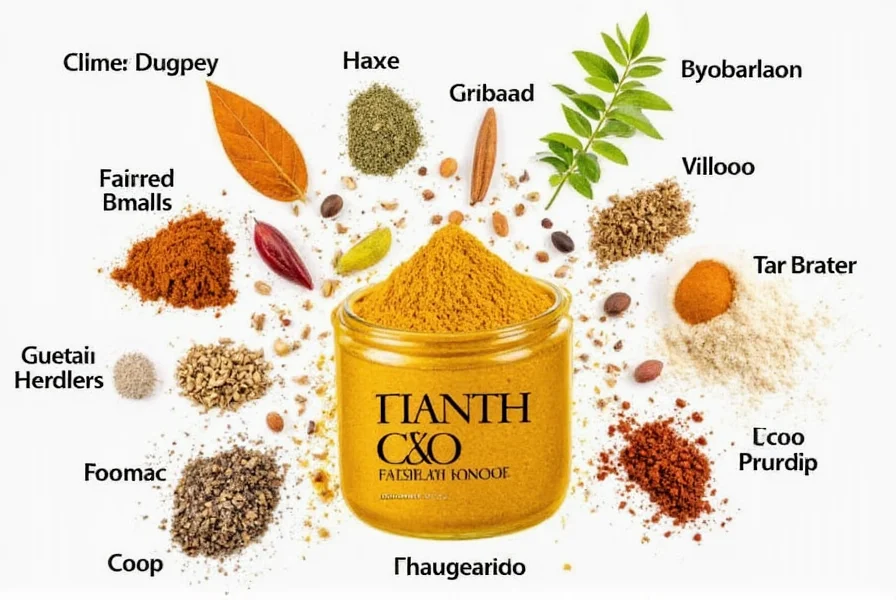What's in Curry Powder? Essential Ingredients Explained
Curry powder typically contains turmeric, cumin, coriander, ginger, and mustard seeds as core ingredients. The exact blend varies by region and recipe, but these spices form the foundation of most commercial and homemade curry powders. This guide breaks down the essential components, regional variations, and practical usage tips to help you master this versatile spice blend.
Table of Contents
| Region | Common Ingredients | Flavor Profile |
|---|---|---|
| India | Turmeric, cumin, coriander, cardamom, cloves | Earthy, aromatic, and often spicy |
| Thailand | Lemongrass, galangal, kaffir lime leaves | Herby, fresh, and sometimes fiery |
| Caribbean | Allspice, nutmeg, cinnamon | Warm, sweet, and smoky |
| Western (e.g., UK) | Turmeric, cumin, coriander, chili | Mild, balanced, and accessible |
Main Ingredients in Curry Powder
Curry powder's flavor profile depends on its core spices:
- Turmeric: Provides vibrant yellow color and earthy base flavor. Always present in authentic blends.
- Cumin: Adds warm, nutty depth essential for savory dishes.
- Coriander: Offers citrusy brightness that balances stronger spices.
- Ginger: Brings zesty heat and aromatic complexity.
- Mustard Seeds: Contributes pungent notes and texture in many traditional recipes.
Additional ingredients like fenugreek, cloves, or garlic powder may be included based on regional variations. The key is that no two curry powders are identical—each reflects local culinary traditions.
Variations Across Cultures
Curry powder adapts to regional tastes:
Indian Curry Powder: Focuses on turmeric, cumin, coriander, and cardamom for complex, aromatic dishes. Often includes asafoetida for umami depth.
Thai Curry Paste: Not technically powder but fresh ingredients like lemongrass, galangal, and kaffir lime leaves create distinctive herbal notes.
Caribbean Curry Powder: Features allspice and nutmeg for sweet-smoky profiles, commonly used in jerk seasoning and rice dishes.
Western-Style Curry Powder: Simplified blends with milder heat, designed for broad palates in dishes like curry chicken or roasted vegetables.
Practical Tips for Using Curry Powder
- Toast whole spices: Heat whole cumin, coriander, and mustard seeds before grinding to unlock maximum flavor.
- Start with 1 teaspoon: Curry powder is potent—add gradually to avoid overpowering dishes.
- Combine with fat: Sauté in oil or butter before adding liquids to prevent clumping and enhance aroma.
- Use in unexpected ways: Try in roasted vegetables, salad dressings, or even chocolate desserts for unique twists.
Buying Guide: Choosing the Right Curry Powder
Key factors to consider:
- Freshness: Buy small quantities and check expiration dates. Ground spices lose potency after 6 months.
- Origin: Indian or Thai brands typically offer more authentic profiles than generic Western blends.
- Ingredients: Avoid products with fillers like wheat or artificial colors. Pure spice blends should list only spices.
Top Recommendations:
- McCormick Indian Curry Powder: Balanced for beginners, widely available
- Penzeys Spices Curry Powder: Premium blend with complex layers for gourmet cooking
- MDH Curry Powder: Authentic Indian brand trusted by home cooks
Frequently Asked Questions
What are the essential ingredients in curry powder?
Turmeric, cumin, coriander, ginger, and mustard seeds form the universal core. Turmeric provides color, cumin adds warmth, coriander brings citrus notes, ginger offers spice, and mustard seeds contribute pungency. Regional variations may include cardamom, cloves, or fenugreek.
Is turmeric always included in curry powder?
Yes, turmeric is present in virtually all authentic curry powder blends. It's responsible for the signature yellow color and earthy base flavor. Some specialty blends may use less turmeric for milder color, but it remains a fundamental ingredient.
How does curry powder differ from garam masala?
Curry powder contains turmeric (giving it yellow color) and is designed as a base for curries. Garam masala lacks turmeric and features warming spices like cinnamon, cardamom, and cloves. It's used as a finishing spice, while curry powder is added early in cooking.











 浙公网安备
33010002000092号
浙公网安备
33010002000092号 浙B2-20120091-4
浙B2-20120091-4